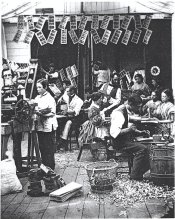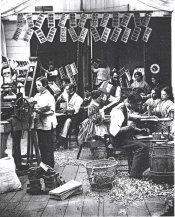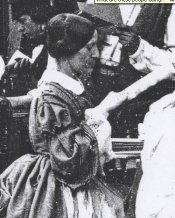Marco B
Subscriber
Going through some photobooks in a library, I stumbled upon this fascinating image. Excuses for the poor reproduction. It is a bad BW copy of an originally sepia toned image, and the original image in the book already showed loads of dust and damages on the reproduction... There are two attached image, a smaller one for a quick overview, the larger one to show some more detail.
It's an image from the book "Nouvelle Histoire de la Photographie" and the original photo was taken by an anonymous photographer in 1865. The image depicts a stereoscopic images studio ("Atelier de photographie stereoscopiques")
I find this image fascinating because of several reasons. First of all, I haven't seen much historic photo's of a photographic "studio" of such old age and of this particular type. We often think of (historic) photographers as "solo" workers, or having maybe two or three assistants. Yet in this image, just 30 years after the invention of photography, we are seeing a kind of full scale reproduction going on on a scale I would not have imagined... I find this very revealing. In addition, there is something very "natural" about it, I really wonder if it's posed or not? If it's posed (and would that have been necessary in 1865?, considering speed of available processes?? Can someone comment on this?), than the photographer has done a pretty good job in hiding it and making it "feel" natural. I like how the people are dispersed in the room, and, despite their numbers, each person is clearly visible and it can be seen what they are doing.
That makes me go to the next point. What are all of these people doing? Clearly, there is some kind of (photo-)mechanical reproduction going on, but what process is used and what are all of these individual persons doing? A few things can be made out easily, clearly the man in the front right part, is using his hammer and some kind of help device to cut of extraneous parts of photos (or reproduced prints). But what are these girls or young women behind him doing? Is one of them using a stamp to mark the reproduced photos as being from this studio? Or something else. And what about all the rest of them? On the left, they are using a press, like used in some sort of "bromoil" transfer process...
Any comments and ideas by others :confused:
It's an image from the book "Nouvelle Histoire de la Photographie" and the original photo was taken by an anonymous photographer in 1865. The image depicts a stereoscopic images studio ("Atelier de photographie stereoscopiques")
I find this image fascinating because of several reasons. First of all, I haven't seen much historic photo's of a photographic "studio" of such old age and of this particular type. We often think of (historic) photographers as "solo" workers, or having maybe two or three assistants. Yet in this image, just 30 years after the invention of photography, we are seeing a kind of full scale reproduction going on on a scale I would not have imagined... I find this very revealing. In addition, there is something very "natural" about it, I really wonder if it's posed or not? If it's posed (and would that have been necessary in 1865?, considering speed of available processes?? Can someone comment on this?), than the photographer has done a pretty good job in hiding it and making it "feel" natural. I like how the people are dispersed in the room, and, despite their numbers, each person is clearly visible and it can be seen what they are doing.
That makes me go to the next point. What are all of these people doing? Clearly, there is some kind of (photo-)mechanical reproduction going on, but what process is used and what are all of these individual persons doing? A few things can be made out easily, clearly the man in the front right part, is using his hammer and some kind of help device to cut of extraneous parts of photos (or reproduced prints). But what are these girls or young women behind him doing? Is one of them using a stamp to mark the reproduced photos as being from this studio? Or something else. And what about all the rest of them? On the left, they are using a press, like used in some sort of "bromoil" transfer process...
Any comments and ideas by others :confused:
Attachments
Last edited by a moderator:















 That's exactly the reason I posted here, since I found it so intriguing.
That's exactly the reason I posted here, since I found it so intriguing.